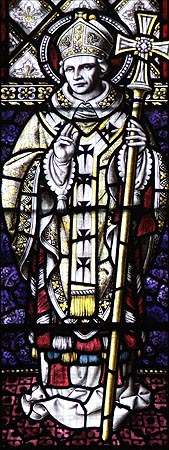 |
 |
|||
|
|
Paulinus, the first Christian missionary to the kingdom of Northumbria, was a "tall man with a slight stoop, who had black hair, a thin face and a narrow, aquiline nose, his presence being venerable and awe-inspiring". He left Italy in AD 601, at the bidding of Pope Gregory the Great, to assist St. Augustine in his work of conversion. With Paulinus, came Mellitus, Justus, and Rufinianus, and they brought, to Augustine, a letter from Gregory, in which the Pope expressed a desire that York should become a metropolitical see with twelve suffiragans. For many years, Paulinus assisted Augustine and Justus in the south of England. However, in AD 625,
King Edwin of Northumbria, still a pagan, married the Christian Aethelburga, daughter of
King Aethelbert of Kent who had received
St. Augustine. Paulinus went with her to her husband's kingdom, having been consecrated - on 21st July AD 625 - by Archbishop Justus as Bishop of the Northumbrians.
The story of Paulinus' labours in the north and the manner in which he succeeded in effecting the conversion of Edwin and of his principal chiefs is well-known. The saint held a famous conference with the highest Northumbrian thegns, probably at a Royal Palace in Londesborough in the East Riding of Yorkshire. Here he explained to them the advantages of the Christian religion, illustrating his arguments thus:
"This is how the present life of man on Earth, King, appears to me in comparison with that time which is unknown to us. You are sitting feasting with your ealdormen and thegns in winter time. The fire is burning on the hearth in the middle of the hall and all outside is warm, while outside the wintry storms of rain and snow are raging - and a sparrow flies swiftly through the hall. It enters in at one door and quickly flies out through the other. For the few moments it is inside, the storm and wintry tempest cannot touch it, but after the briefest moment of calm, it flits from your sight, out of the wintry storm and into it again.So this life of man appears but for a momnet. What follows or, indeed, what went before, we know not at all."
Having been offered hope of life after death, the thegns were won over. Even the King's pagan high priest, Coifi - probably motivated by hopes of his own survival - rode out to the great pagan temple at Goodmanham, a very short distance from Londesborough, threw a spear into it and began its demolition. The present parish church there may possibly occupy the site. Shortly after this conference, the baptism of Edwin took place, at York, on Easter Day (12th April) AD 627. Two of his children, and many other persons of noble birth, were baptised at the same time. Round the baptistery, which had been hastily built, the King caused a small stone church to be constructed. It stood somewhere in the vicinity of the present minster, under which its cemetery has been excavated.
The kingdom of Edwin embraced the whole country from the Humber to the Clyde and the Forth and there are traces of Paulinus and his labours in many parts of this vast district. According to Bede, he used to baptise in the river Swale, near "Cataractum" - the modern Catterick. Local tradition asserts that he baptised at Brafferton, also on the Swale; and the position of the church on the bank of the river may have been intended to commemorate the fact. "Paulin's Carr" and the "Cross of Paulinus," in the adjoining parish of Easingwold, are both mentioned in an Inquisition of the reign of King Edward I. He apparently built a church in Leeds (Campoduno) and ancient crosses, were connected with his name at nearby Dewsbury and at Whalley. While "Pallinsburn" and "St. Paulinus' Well" occur in Northumberland. Here also, at Yeavering in the Cheviots, he is said to have spent thirty-six days in catechising the converts - probably from the grandstand excavated there - and baptising them in the river Glen. Edwin's kingdom, or at least his influence, extended at one time south of the Humber. At Lincoln, in ancient Lindsey, St. Paulinus built a small church at the insistence of Blaecca, the "praefectus" of the city, whom he had converted. Paulinus consecrated
Archbishop Honorius of Canterbury here in AD 628. The church was, almost certainly, St. Paul's-in-the-Bail, erected in the centre of the ruinous Roman Forum. Along with St. James the Deacon, he baptised in the Trent at Littleborough in Nottinghamshire and he is also said to have founded Southwell Minster in the same county.
In AD 633, King Edwin fell in the Battle of Hatfield Chase (Nottinghamshire). It was unsafe for the Queen to remain in Northumbria and Paulinus returned with her to Kent. International communications were, not surprisingly, poor in those days and, unaware of this new state of affairs, Pope Honorius I wrote to King Edwin and Archbishop Honorius of Canterbury in June the following year, sending the pallium for, now exiled, Paulinus.
Bishop Romanus of Rochester having died, Paulinus was immediately given his see, which he presided over until his death on 10th October AD 644. He was buried in the chapter-house of the cathedral there, but Archbishop Lanfranc translated his relics and placed them in a beautiful silver shrine. The name of Paulinus was inserted in the Calendar and he became the great Patron Saint of Rochester.
*
* * There is no merit in the old theory that Paulinus was the adopted Christian name of Prince Rhun ap Urien of Rheged who is recorded by Nennius to have baptised King Edwin. This was probably an early conversion, during his younger years of exile, which later lapsed. Paulinus was a true Italian, as reported by Bede who received his information from the Abbot of "Peartaneu" in Lincolnshire, to whom it had been given by an old man whom Paulinus, in the presence of Edwin, had baptised in the Trent. Edited from Richard John King's "Handbook to the Cathedrals of England: Northern Division" (1903).
|
|||
| © Nash Ford Publishing 2003. All Rights Reserved. | ||||





